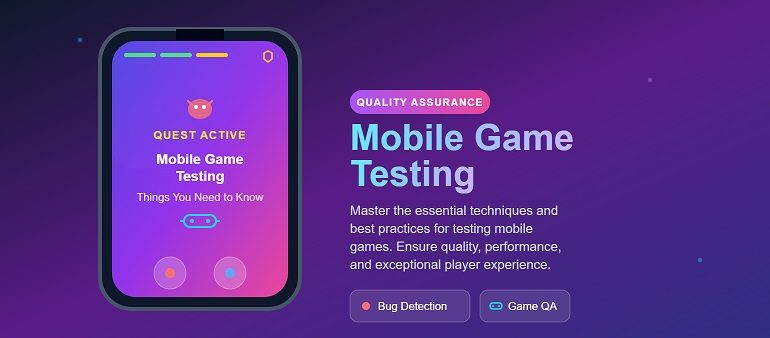What is mobile game testing and why is it important?
You’ve seen it happen. That moment when a game looks stunning, sounds perfect… and then lag. A stutter. A crash.
Gone. The player closes the app. No complaints. No feedback. Just silence. The deadliest kind of churn. That one moment of friction can undo months of design and code that game app developers put their soul into.
That’s why mobile game testing exists. It’s the process that makes sure every tap, swipe, and frame lands exactly how it should. Gameplay. Performance. Stability. Compatibility. Security. Player experience - across real devices. All check-marked!
Testing gameplay, performance, stability, compatibility, security, and player experience across real devices, OS versions, regions, and networks before launch and long after it, is what makes a game successful. Testing ensures your controls feel fluid, your combat fair, your monetization trustworthy, and your sessions stable. It protects revenue streams, store approvals, and reputations.
So the question is not if to test, but how to test well enough that the experience holds under real pressure.
Identifying Risk Factors in Game Market Launches
Every launch has pressure points. Here’s where they hide:
- Device fragmentation: Different chipsets, GPUs, RAM, refresh rates, notches, and thermals can break UI or input in ways you won’t see until it’s too late. Mid and low-end devices are often the biggest revenue slice and the biggest risk.
- Network volatility: Packet loss, jitter, and 4G-to-5G handovers eat PvP alive. Leaderboards, cloud saves, and matchmaking don’t survive peak-hour chaos without planning.
- Performance cliffs: Memory leaks, shader hitches, CPU or GPU spikes, and thermal throttling appear in long sessions and dense scenes, not short smoke runs.
- Monetization failure paths: IAP receipt errors, misfired rewards, and ad SDK timeouts silently bleed trust and ARPDAU.
- Compliance gaps: Age ratings, privacy prompts, and store policy mismatches are launch-blocking landmines.
- Localization misses: runcation, right-to-left layout bugs, and cultural slip-ups reduce retention in key markets.
- Regional regulatory variance: Kids categories (for example, COPPA), consent or ATT flows, and data minimization rules differ by platform and market. Plan per region test passes.
- Live ops instability: Event configs, remote content, and in-app stores can break your economy overnight.
Reasons enough to understand the significance of solid game testing?
Exploring the Primary Types of Mobile Game Testing
Mobile Game Load Testing
This involves simulating real player chaos, including spikes, region load, and long sessions. Latency, error rates, and autoscaling are watched so the backend does not melt on day one. It also includes tournament spikes, store refreshes, and rolling restarts to prove the game bends without breaking.
A/B Testing for Mobile Games
In this game testers optimize onboarding, difficulty, economy, ad cadence, and HUD layouts using predefined KPIs such as FTUE, D1 or D7 retention, and ARPDAU. Non overlapping tests are used with holdouts and pre-registered hypotheses to avoid attribution noise. Segmentation by device tier, network quality, and region, is done, and secondary impacts monitored, such as hitch count, battery, and session length.
Functional Testing
The game’s heartbeat, like core loops, physics, inventory, save/load, permissions and deep links are tested in this phase. Duplicate rewards, misfired currency, and inconsistent state transitions are caught. Validating your economy rules before they go live is also done, because nothing breaks immersion like a missing sword or a vanishing coin.
Security Testing
Cheaters are testers too, just not the kind you invite to the credits. They hunt for gaps in your logic, twist your systems, and turn exploits into bragging rights before you even hit publish.
Game testers lock the core: keep critical decisions on the server, encrypt every handshake, and make the game self-aware with environment checks. They run drills against real attack patterns such as speed hacks, emulator spoofing, packet tampering, and leaderboard forgery, and watch how your systems react under pressure.
Verify that your detection, logging, and enforcement are battle-ready before the bad actors even hit “connect.”
Mobile Game Compatibility Testing
Your audience doesn’t play on “average hardware.” Testers maintain a live device matrix that reflects real markets. Test controllers, refresh rates, sensors, notifications, and orientation changes. Update quarterly. Minimum OS and GPU families per region? Non-negotiable.
Usability Testing
Watching players play can be so significant. Testers measure time to first fun, tutorial clarity, and readability under pressure. They also add accessibility checks: text scaling, colour-blind presets, haptics, captions. Then they go physical - real device, real hand, real reachability.
That’s how you design for actual humans, not test plans. Logic Simplified does this!
Localization Testing
This testing involves validating translations in context, pluralization, truncation, font fallbacks, RTL layouts, and local date or number formats. A check of ratings or legal text and store assets per region is carried out. Cultural QA for idioms, jokes, symbols, and holiday or event names can be added too.
Alpha Testing for Mobile Games
Alpha is your lab: stability, performance budgets, and pacing.
Beta is your battlefield: scale, telemetry, and live feedback. Alpha Testing uses cohorts, canary builds, and rollback plans. Store flows and refund processes are rehearsed before you hit publish.
Performance Testing
In performance testing, heavy scenes and shader spikes are profiled. Frame pacing is to be kept consistent. Measuring cold starts, warm starts, and OOM behaviour on low and mid tiers is important. Testers also lock builds to target FPS budgets by scene, and track thermal rise as a pass/fail metric, not an afterthought.
Graphics and Battery Consumption Analysis
Gorgeous shouldn’t mean “battery-killer.”
A/B test bloom, motion blur, and dynamic resolution to keep visuals crisp without cooking your player’s phone.
Recovery Testing
This is quite like simulating chaos. Network drops, app kills, incoming calls are seen. Testers check how gracefully your game recovers - from state resume to purchase retries. Offline modes matter too. Players forgive downtime; they don’t forgive lost progress.
Mobile Game Beta Testing
Scaling on real devices, regions, and networks is essential. Telemetry and qualitative feedback is tested. What do beta testers do? They use staged cohorts and canary builds. Stress live events. Rehearse store flows. Design cohorts by device tier and network quality, and enable rapid feature flag rollbacks and experiment killswitches during beta.
Logic Simplified offers expert game-testing services as a part of its game development process. Get in touch to know more.
Overcoming Challenges in Mobile Game Testing
Addressing Security Concerns
Security isn’t just a technical checkbox; it’s part of the game’s trust contract. Players trade their time, data, and sometimes their money for a fair experience, and that promise is worth defending.
Keeping your core logic on the server keeps it from getting tampered with. Protecting every transaction with validation, and log receipts so disputes can be traced instead of guessed helps. Also watch for anomalies that signal cheating, fraud, or network manipulation before they spiral into player frustration.
Think of it this way: fair play isn’t just good ethics, it’s good business. When players trust your world, they stay longer, spend smarter, and share louder.
User Interface Evaluation
Your game needs to be tested like it’s being played on a park bench at noon, not just under perfect studio lights. Check how it feels with sweaty hands, shaky signals, and the chaos of real life.
UI testing makes sure text scales cleanly, HUDs stay readable, and every tap zone respects human thumbs, not robotic precision. Adding colour-blind options, safe-area logic, and controller remapping that actually remembers the player is important.
Your UI should never vanish under glare or hide behind a notch; it should hold up wherever your players show up.
Key Metrics in Mobile Game Testing
- Stability: crash free sessions, crash rate, ANR rate, and mean time to failure across device and OS matrices.
- Performance: FPS, frame pacing, load time, memory ceilings, CPU/GPU load, thermal rise.
- Network: RTT, jitter, packet loss, reconnect time, matchmaking time, rollback frequency, and timeout or error rates.
- Usability: FTUE completion, time to first fun, tutorial skips, hint usage, navigation errors, and rage taps.
- Monetization: IAP success, receipt errors, reward delivery latency, ad fill or viewability, and frequency caps.
- Localization: string coverage, truncation rate, layout defects, and locale specific crashes or ANRs.
- Retention: D1, D7, and D28 because engagement tells the truth.
- Compliance: Consent prompts, ATT opt-ins, and store checklist passes.
- Multiplayer health:Match success, rollback frequency, anti-cheat accuracy.
- Live ops SLIs or SLOs: Reward delivery and store call success within SLA targets.
Overview of Top Mobile Game Testing Tools
- Automation and CI: Unity Test Framework or AltUnity for engine aware tests. Appium, Espresso, and XCUITest for stable UI and regressions integrated into CI or CD.
- Device clouds: real device farms expand OS, hardware, and geography coverage without owning a massive lab.
- Performance profilers: Unity Profiler, GPU frame debuggers, platform traces, and vendor tools for FPS, frame pacing, memory, hitches, and battery.
- Network simulators: latency, jitter, bandwidth caps, packet loss, and captive portals to mirror real world conditions in labs and pipelines.
- Crash or telemetry SDKs: crash analytics, ANR tracking, session replays, and event pipelines to prioritize fixes by player impact.
- Beta distribution: managed rollouts, canary flags, and structured feedback loops for safe scale up.
- Observability wiring: Prebuilt dashboards for FPS, network health, IAP funnels, and reward latency - wired straight to your release gates.
Final Thoughts
Great teams do not treat testing as cleanup; they run it as a product strategy with uncompromising CI or CD gates for stability, performance, network behavior, and compliance, and a living device and network matrix that evolves with markets and hardware. Quality is not a checkbox; it is an advantage that cuts time to fix, reduces store rejections, and protects crash free sessions where it counts.
At Logic Simplified we understand this. We are a top game development company, where games are not only built well, but tested until they are bulletproof! From puzzle loops to RPGs, card games to board games, we leave no stone unturned in making sure the game is launch-ready. So whether you are starting your own game app business or wanting to convert your game idea into a Unity or Unreal best-seller, this is where we keep things unshakeable. Write to us at enquiry@logicsimpified.com or contact us to know more.
 Get a Quote
Get a Quote












